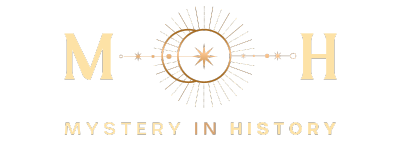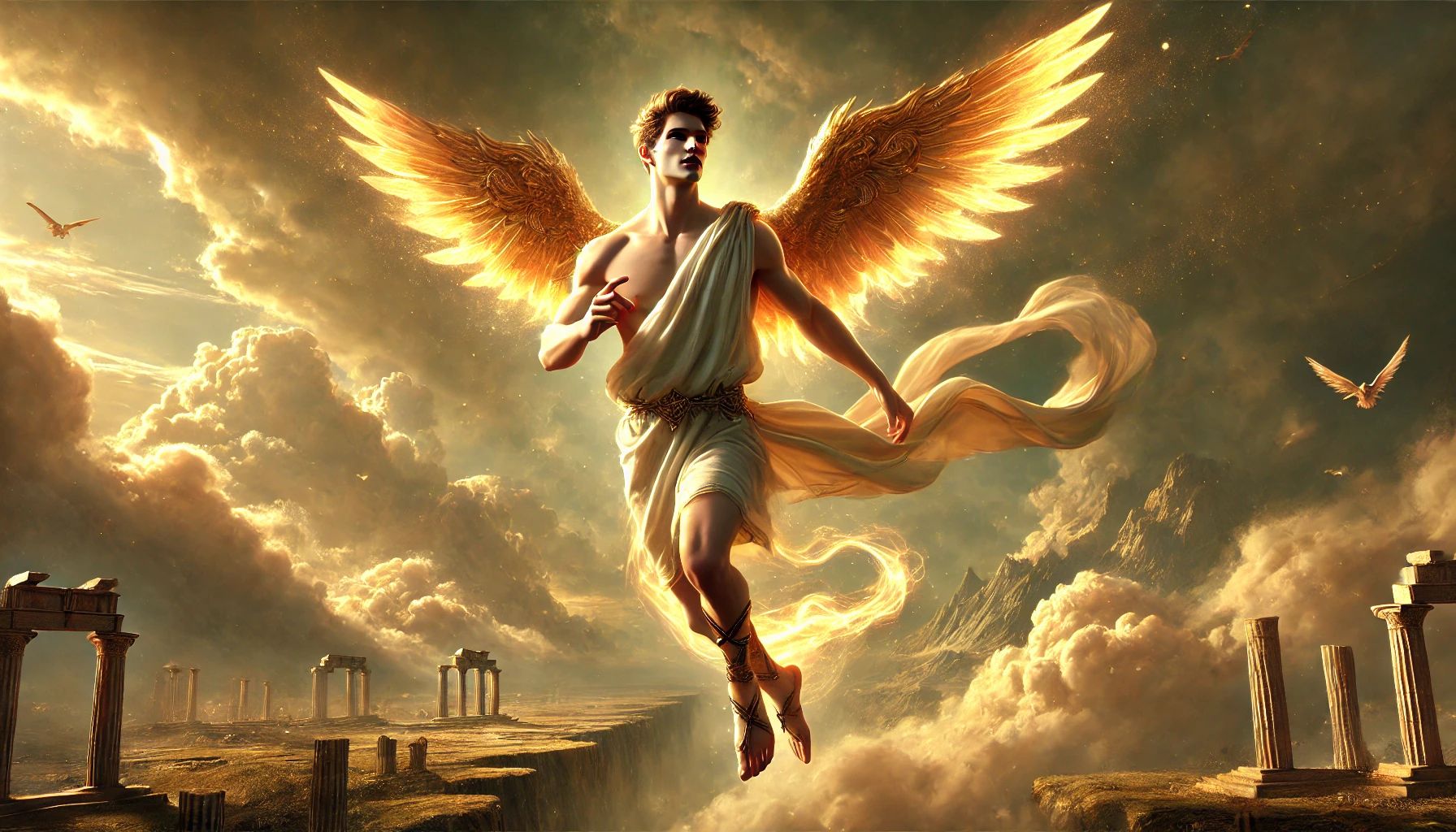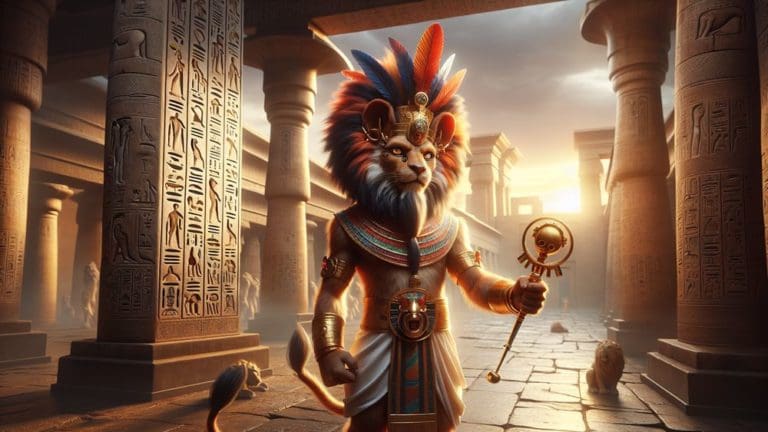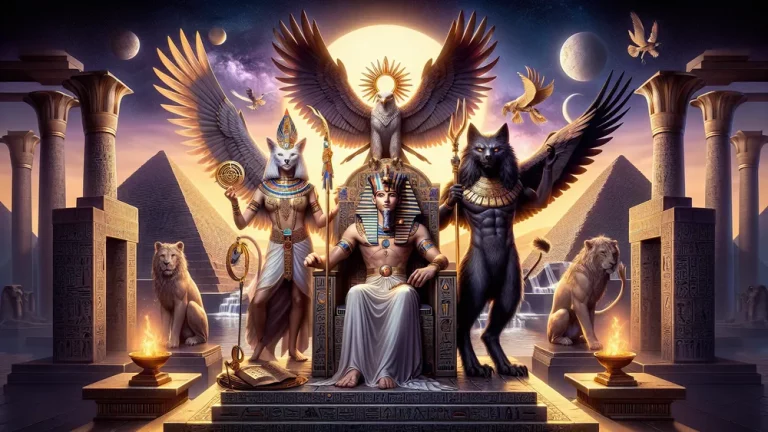Hermes: Greek God Of Trade, Messenger, And Trickster
When you think of Greek mythology, names such as Zeus, Hera, and Poseidon might be the first ones you recall. Yet, one of the most interesting and many-sided gods is Hermes.
Key Points:
- Hermes is the Greek god of trade, a messenger of the gods, and a clever trickster.
- Born to Zeus and Maia, Hermes showed his cunning nature from birth, stealing Apollo’s cattle on his first day of life.
- As a messenger, he’s known for his speed and carrying the caduceus, a staff with two snakes around it.
- He’s also respected as the god of trade and business, being a protector for merchants and traders.
- Hermes guides souls to the underworld, a role that underpins his importance in Greek myths.
- He’s recognized by his symbols, including wing-ed sandals, the caduceus, and the lyre, an instrument he made himself.
- In ancient Greece, he was honored with various temples, shrines, and festivals.
Picture a figure who could be similar to a modern-day person who does many things: a messenger who delivers important details, a smart businessman, a guide for souls, and a cunning trickster. Hermes, the Greek god of trade, messenger of the gods, and clever trickster, fills all these roles and more.
In this blog post, we will look into the different parts that make up who Hermes is and his importance in old Greek culture. Starting with his godly family tree and early adventures, followed by his job as a messenger and his big effect on trade and business, we will go through the rich stories and myths about this fascinating deity.
Whether you’re just starting out with Greek mythology or want to know more, this thorough guide will give you a detailed look at Hermes, one of the most dynamic figures in the Greek pantheon.
Hermes: Overview and Key Facts
| Key Aspect | Information |
|---|---|
| Name | Hermes |
| Parents | Zeus (father) and Maia (mother) |
| Roman Version | Mercury |
| Symbols | Caduceus (staff), winged sandals, winged helmet, lyre |
| Areas | Trade, commerce, communication, travel, thievery, guiding souls |
| Qualities Worth Mentioning | Cunning, resourcefulness, speed, speaking well |
| Sacred Animals | Tortoise, rooster, ram |
| Sacred Plants | Crocus, strawberry-tree, palm |
| Main Jobs | Messenger of gods, guide to the underworld (psychopomp), patron of merchants and thieves |
| Important Myths include | Hermes stealing Apollo’s cattle, inventing the lyre, guiding souls to the underworld, and helping heroes like Odysseus |
| Worship | Worshipped all over old Greece, with many temples and shrines for him |
| Festivals | Hermaea, a festival for Hermes’ sports and clever qualities |
Where Hermes Came From
Interestingly, to fully grasp Hermes, we first need to look into where he comes from because that is important. Start with his birth and family connections.
His Birth and Family Ties
Zeus, the main god, and Maia, a Pleiad and Atlas’s daughter, had Hermes. As the myth tells it, Maia gave birth to Hermes in a hidden cave on Mount Cyllene in Arcadia. Think of a child born into an important family, meant for big things from birth. His divine family background set Hermes apart right away, giving him unique traits and a big role among the gods.
Zeus had many children who were important in the pantheon, and Hermes was one of them. From birth, Hermes had amazing skills and a tricky nature. He was different. Interestingly, on the day he was born, he left his cradle for adventures, revealing his cleverness and resourcefulness.
His mother, Maia, tried to keep him hidden from the other gods, but Hermes’ talents couldn’t stay hidden for long. Since he was the son of Zeus, Hermes got a position of influence and power, which let him move up in the divine ranks easily.

This ancestry not only gave him divine traits but also made him a go-between and messenger among the gods, a job that would describe much of his mythological story.
Zeus and Maia had Hermes, a special child with unique traits and skills, born in a hidden cave, destined for greatness due to his divine heritage, positioning him as a key figure in the world of gods, acting as a messenger and intermediary.
His Early Adventures and Deeds
Interestingly, one of Hermes’ most famous early deeds is the stealing of Apollo’s cattle. The day he was born, Hermes left his cradle and went out to take fifty of Apollo’s sacred cattle. To cover his tracks, he cleverly made the cattle walk backward and made sandals for himself to hide his footprints. Think of a child doing a tricky thing, outsmarting everyone around him.
This act of cunning not only meant Hermes was resourceful but also began his fame as a trickster. Apollo found out about the theft and confronted Hermes, who at first denied the act but then gave back the cattle, creating a bond between the two gods. Hermes also invented something. A lyre. This musical instrument became famous in Greek stories.

Using a tortoise shell, Hermes made the first lyre by putting strings across the hollow shell. This invention was not only a sign of his ingenuity but also was important in fixing his relationship with Apollo. When Apollo confronted Hermes about the stolen cattle, Hermes gave the lyre as a gift, which Apollo accepted, being enchanted by its beautiful sound.
This act of creativity and diplomacy highlights Hermes’ multifaceted nature, mixing his trickster spirit with a talent for invention and making peace.
What Hermes Does
Since we’ve looked into where Hermes came from and what he did early on, let’s jump into the different jobs he had among the gods.
Messenger Duties
Hermes was the godly messenger and played a critical role in talking between the gods and humans. Think of him as a heavenly messenger, whose job was carrying important messages quickly and correctly. His winged sandals, which were called the Talaria, meant his speed and his ability to travel easily between the gods and humans.
Not only that, Hermes carried the caduceus, a staff with two snakes around it, which was a sign of his power and his job as a go-between. These traits meant Hermes did his job very well. The gods’ wishes got communicated clearly. Hermes’ jobs as a messenger were big and different. He was asked to carry important messages, like commands from Zeus or news of big events.
For example, Hermes was the one who told Calypso about Zeus’ order to let Odysseus go, letting the hero keep going home in Homer’s “Odyssey.” This step was key in the story. It means Hermes had a significant part in the story of humans.
Another time, Hermes led Persephone back to the world’s surface, reuniting her with her mother Demeter and ending the time of no crops on Earth.
Here are some notable messages carried by Hermes and their impact on Greek mythology:
- Zeus’ command to Calypso: Ordered her to release Odysseus, letting him go home.
- Leading Persephone: Reuniting her with Demeter, bringing back crops to the Earth.
- Bringing Pandora to Epimetheus: Bringing Pandora, whose curiosity let all evils into the world.
- Telling Aegisthus of Agamemnon’s return: Setting up the sad events in the “Oresteia.”
These examples mean Hermes had an essential part in shaping the stories of Greek mythology, showing his importance as the godly messenger.
God of Trade and Business
Hermes was respected as the god of trade, business, and money, having a vital part in the money life of ancient Greece. He was like an old-time protector for merchants and traders, making sure they did well and were successful. His power reached all parts of trade, whether in market deals or faraway trade paths.
Often, merchants prayed to Hermes for good luck and safety on their business trips, offering him sacrifices and setting up shrines for him. Because he was linked with money and trade, he was a key god for anyone involved in business, underlining his importance in the daily lives of the ancient Greeks.
Guide to the Underworld
Hermes, as the guide, had the serious job of leading souls to the underworld, a role that meant he was flexible and very important in Greek myths. Think of him as a kind guide who helps souls move through the unknown and often scary journey to the afterlife. This job was so souls could get to their final resting place in Hades‘ area.

The ancient Greeks thought Hermes would gently guide the dead from the world of the living to the underworld, giving comfort and also direction. Rituals linked to this side of Hermes’ godliness often included prayers and sacrifices to make sure the dead had a safe trip, which underlined the great respect and reliance placed on Hermes in this serious job.
Guides souls to the underworld, Hermes’ role is crucial in Greek myths, portraying him as a compassionate companion aiding them through the unknown path to the afterlife, with rituals honoring his role in guarantee the safe passage of the deceased.
Patron of Thieves and Tricksters
Hermes’ fame as the god of thieves and tricksters shows his cleverness and ability, making him great at tricking and planning. Imagine him as really good at tricks or planning who always stays ahead. A well-known myth that shows this side of Hermes is his stealing of Apollo’s cattle. This happened right after Hermes was born.
Hermes, using his cleverness, hid his tracks by making the cattle walk backward, making it hard for anyone to follow. When Apollo found out, Hermes impressed him by giving him the lyre, an instrument he had created from a tortoise shell.
This story means Hermes’ smart thinking and his ability to turn negative situations to his advantage, establishing his role as the god of thieves and tricksters in Greek myths.
Hermes’ Symbols and Looks
After we looked at Hermes’ different roles and jobs, let’s look into the symbols and features which show his looks and importance in Greek myths.
The Caduceus and Its Meaning
The caduceus, Hermes’ famous staff, is a sign full of meaning and past. Imagine it like a thin stick with two snakes wrapped around it, and wings on top. This staff means Hermes’ jobs like being a carrier and a middleman, meaning talking, deals, and harmony. However, it’s often mixed up with the rod of Asclepius, that has one snake and is linked with medicine and healing. To help you tell apart these two signs, here’s a difference:

| Feature | Caduceus (Hermes) | Rod of Asclepius (Asclepius) |
|---|---|---|
| Number of Serpents | Two | One |
| Wings | Yes | No |
| Linked with | Communication, Commerce | Medicine, Healing |
| Deity | Hermes | Asclepius |
Understanding these differences helps clarify the distinct roles and signs of Hermes and Asclepius in Greek myths.
His Winged Sandals, Helmet, and Lyre
Hermes’ winged sandals, called the Talaria, and his helmet, the Petasos, are famous signs of his speed and ability to move. Think of the Talaria as old-time fast running shoes. They let Hermes cross the areas of gods and mortals quickly. The wings on these sandals mean he works as the messenger of the gods.
Also, the Petasos, sometimes shown with wings, means he is quick and ready for any journey or job. Together, these things mean Hermes can move freely and quickly, making him a needed go-between among the gods. Also, aside from his fast gear, Hermes is known for making the lyre, a musical instrument important in Greek myths.
The myth says he made the lyre from a tortoise shell on the day he was born. He used the shell to make sound and attached strings made from sheep gut, making an instrument that produced charming music. This not only showed Hermes’ smart thinking and creativity but also helped him make peace with Apollo after stealing his cattle.
The lyre became a symbol of harmony and artistic expression, which helped Hermes be known for many things and his help to both gods and mortals.
Hermes in Greek Life and Worship
After we checked out Hermes’ signs and unique features, let’s see how people respected and admired him in old Greek community.
Temples and Shrines for Hermes
All over old Greece, many temples and shrines were set up for Hermes, showing his value in different parts of life. These holy places were where people could honor Hermes with ceremonies and gifts. For example, the Temple of Hermes in Pheneos was a big place for worship, where followers left gifts of honey, cakes, and fragrance to ask for his help. The Hermaion at Mount Cyllene, thought to be where he was born, attracted visitors who did ceremonies to get his safety and blessings. Here are some important temples and shrines that were set up for Hermes:
- Temple of Hermes in Pheneos
- Hermaion at Mount Cyllene
- Hermes’ Sanctuary in Tanagra
- Hermes’ Altar in the Agora of Athens
- Hermes’ Shrine in the Gymnasium of Elis
These places were part of the religious landscape of old Greece, giving spots for worshippers to connect with Hermes and ask for his guidance in daily life.
Festivals and Celebrations
Festivals and celebrations to celebrate Hermes, like the Hermaea, were very important in old Greek culture. For example, the Hermaea was a festival mainly for young men, especially in gymnasiums, where they held athletic competitions and games to honor Hermes as the supporter of sportspeople. Think of it like an old-time sports day, where participants engaged in many physical contests to appear strong and agile.
These events were not only a tribute to Hermes’ own speed and skill but also a way to ask for his blessings for winning and safety. Gifts like food, wine, and fragrance were given, and group gatherings encouraged a feeling of togetherness and respect for the god.
These celebrations showed Hermes’ many-sided nature and his effect on both single people and groups in life.

Celebrations and festivals for Hermes, such as the Hermaea, were vital in ancient Greek society, resembling a sports day where young men competed to honor Hermes and seek his blessings, fostering unity and respect through athletic feats and communal offerings.
How Hermes Shows Up in Art and Literature
Hermes has been a well-known figure in old Greek art and writing, usually shown with his famous winged shoes, hat, and stick. Throughout art, Hermes appears in different forms, from detailed vase paintings to big sculptures.
For example, the well-known statue “Hermes and the Infant Dionysus” by Praxiteles shows him in a moment of gentle care, pointing out his part as a guide and protector. In stories, he appears often, like in Homer’s “Iliad” and “Odyssey,” where he works as a divine helper and guide. These images both highlight his many-sided nature and also show his importance in Greek life.
Think of Hermes as a flexible character in many famous stories, each time adding more depth to his character and strengthening his value in the myth stories. These art and writing depictions have left a lasting mark, shaping our understanding of Hermes and his place in old Greek society.
Pantheon of All the Greek Mythology Gods
To understand the Greek gods, you should know that they were a large group of powerful beings who ruled over various aspects of life and the world. There was Zeus, who was the king of the gods and controlled the sky and thunder. Hera, his wife, was the goddess of marriage and family. Poseidon ruled the seas, and Hades controlled the underworld.
Among them were other important gods like Athena, who was the goddess of wisdom and war, and Apollo, the god of the sun, music, and prophecy. Artemis was the goddess of the hunt and the moon, and Ares was the god of war. Each god had specific powers and responsibilities, making them essential to the Greek understanding of the world.
FAQs
1. What are Hermes’ most famous myths?
Hermes’ most famous myths include his theft of Apollo’s cattle and his role in guiding souls to the underworld.
2. How did Hermes become the messenger of the gods?
Hermes became the messenger of the gods when Zeus appointed him due to his speed, cunning, and reliability.
3. What symbols are associated with Hermes?
Symbols associated with Hermes include the caduceus, winged sandals, and the lyre.
4. How was Hermes worshipped in ancient Greece?
How Hermes was worshipped in ancient Greece involved rituals, offerings, and festivals dedicated to him.







